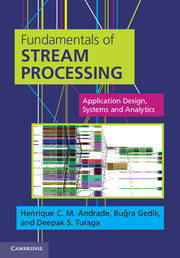Book contents
- Frontmatter
- Dedication
- Contents
- Preface
- Foreword
- Acknowledgements
- List of acronyms
- Part 1 Fundamentals
- Part II Application development
- Part III System architecture
- Part IV Application design and analytics
- Part V Case studies
- 12 Applications
- Part VI Closing notes
- Keywords and identifiers index
- Index
- References
12 - Applications
from Part V - Case studies
Published online by Cambridge University Press: 05 March 2014
- Frontmatter
- Dedication
- Contents
- Preface
- Foreword
- Acknowledgements
- List of acronyms
- Part 1 Fundamentals
- Part II Application development
- Part III System architecture
- Part IV Application design and analytics
- Part V Case studies
- 12 Applications
- Part VI Closing notes
- Keywords and identifiers index
- Index
- References
Summary
Overview
In previous chapters we covered different aspects of the stream processing paradigm, including its software engineering and systems aspects, as well as its analytical foundations. In this chapter, we make use of this knowledge by taking a closer look into the design of real-world applications.
We present three applications from different business domains: a large-scale systems operations monitoring application used to manage a portion of an IT software environment, a patient monitoring application used in the context of clinical healthcare, and an application for semiconductor fabrication process control used in a manufacturing environment.
Each of these applications is described from the perspective of a system analyst who has to design the appropriate software solution. Hence, we cover the entire software engineering process, starting from gathering the requirements, designing and implementing the application components, and finalizing with the stages of optimization and refinement.
The first application, which we label Operations Monitoring (OM), is focused on analyzing log messages and events capturing the resource usage of various operational processes in a large-scale networked system shared by multiple users and processes (Section 12.2). Its aim is to continuously monitor the state of that environment, enforcing appropriate resource usage policies, as well as detecting (and potentially predicting) system outages.
This application is a front-end to different analytic applications. Its primary challenge consists of dealing with the scalability and performance requirements associated with handling large volumes of streaming data.
Information
- Type
- Chapter
- Information
- Fundamentals of Stream ProcessingApplication Design, Systems, and Analytics, pp. 441 - 484Publisher: Cambridge University PressPrint publication year: 2014
